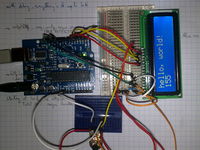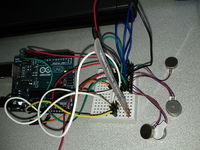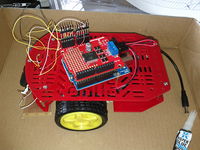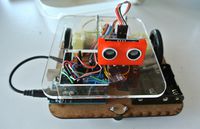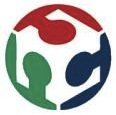UE X2 Introduction Physical Computing
Introduction à l'Informatique Physique / Introduction to Physical Computing (PhyComp)
Date: Ouverture Janvier 2014
Contact: David Eon.
Volume Horaire : 60 h (18 h CM et 42 h TD/TP/Projet tutoré)
Code APOGEE : ???
Prerequisites : Elementary notions of programming and electronics. Notions in C or Java languages are appriciated but not mandatory.
Topics: Computer Sciences, Electronic, Instrumentation
L'informatique physique (Physical Computing en anglais, PhyComp en abrégé) se concentre sur les interactions avec le monde physique en utilisant une variété de capteurs et actionneurs qui sont contrôlées par des microcontrôleurs et par des ordinateurs. Une caractéristique importante est que les développeurs ne sont habituellement pas des spécialistes de l'informatique embarquée et omniprésente . Il en résulte des outils de développement qui mettent l'accent sur la simplicité de programmation et de développement de ces types d'applications.
The Arduino project is a prime example of this movement. It offers both an experimental board, built around a low cost microcontroller with a few input-output ports, and an integrated development environment that simplifies its usage. This board is now extensively used in a large array of contexts, including: rapid prototyping, testing and education around physical computing.
This module introduces the technical aspects of development with the Arduino platform and presents the user community that has grown around it. It offers an opportunity to gain experience on the Arduino platform by prototyping physical computing applications with a mix of sensors and actuators including making the things shells in a fablab using laser cutters, 3D printer, ... (see pictures below).
Program Summer 2013
Part I : Basics in theoretical and practical electronics
Instructors: Sophie Chareyron, David Eon, Maxime Besacier
Duration : 4 hours
Location: Polytech Grenoble
All you need to know to start in electronics !
Part II : Introduction to Physical Computing with Arduino
Instructor: O. Richard
Duration: 16 hours
Location: Polytech Grenoble
Dedicated page: Introduction to Physical Computing
- Introduction Physical Computing
- Definition, Principles and Examples
- Presentation Arduino Project in brief
- Arduino Board, Environment
- Arduino Language
- Practicals: First Arduino Board Use
- Components of Physical Computing
- Microcontroller in brief
- Sensors and Actutors
- Arduino Language:
- Variable, Control Structure
- Input/Ouput Operations
- More about Language
- Practicals: Second Arduino Board Use
- Communication: Computer - Arduino
- Serial, Bluetooth, Xbee (with Android phone)
- Language for Computer: Processing
- Practicals: Advanced cicuits
Part III : Robotic with Arduino
Instructors : Sophie Chareyron, David Eon, Maxime Besacier
Duration: 16 hours
Location: Polytech Grenoble
- Basics in Robotics
- Motors driving (power electronics)
- Object detection (interfacing sensors)
- Programming of robot’s behaviors : path following, Labyrinth exploration, ...
- Communication between robots (IrDA, zigbee, bluetooth)
- Student project (by group of two) : Design and realization of an autonomous mobile robot based on the Magician Chassis
Part IV : Introduction to Fablab (Factory Laboratory)
Instructor: Jean-Michel Molenaar
Duration: 8 hours (one morning, one afternoon)
Location: CCSTI Grenoble
- Introduction : What is a "Fablab" (Factory Laboratory)?
- Visit of the CCSTI Expo on Fablab
- Introduction to the lab, the machines and the tools : laser cutters, vinyl cutter, CNC mill, reprap, 3D printers.
- Class on digital construction (CAD / CAM)
- Designing / cutting / adapting / expending of robot Magician Chassis.
- ‘Homework’ : design a snap fit construction kit
- Review of homework
- Cutting / milling of kits
- Construction
- Evaluation / ideas for new projects / possible uses
Part V : Introduction to Product Design
Instructor: Jean-Baptiste Joatton (Pôle Supérieur de Design de Villefontaine)
Duration: 2 half-days
Location: CCSTI Grenoble
- Introduction : design school of Villefontaine
- Panorama : more than 50 design disciplines
- Design definitions
- Review of a few design process (Design thinking)
- Design in business (Design ladder)
- Interaction design short workshop ("Visit an exhibition")
Livres
- Massimo Banzi, Getting Started with Arduino, Pub. Make; 1 edition (October 15, 2008) ISBN-10: 0596155514
- Tom Igoe, Making Things Talk: Practical Methods for Connecting Physical Objects, Make; 1 edition (September 28, 2007), ISBN-10: 0596510519 (source of examples). Second Edition, Released: August 2011 (est.) ISBN-10: 1449392431, ISBN-13: 978-1449392437, http://oreilly.com/catalog/0636920010920
- Joshua Noble, Programming Interactivity: A Designer's Guide to Processing, Arduino, and OpenFrameworks, O'Reilly Media, July 2009 (source code)
- Jonathan Oxer et H. Blemings, Practical Arduino: Cool Projects for Open Source Hardware, Apress, Janvier 2010, http://www.practicalarduino.com, http://books.google.fr/books?id=iwzo1-zmVXEC
- Donald A. Norman, The Design of Everyday Things, Publisher: Basic Books; ISBN-13: 978-0465067107, google books
Ressources
- Physical Computing: http://www.tigoe.net/pcomp/
- Arduino: http://www.arduino.cc/
- Pratice support: http://www.sparkfun.com/tutorial/AIK/ARDX-EG-SPAR-PRINT-85.pdf
- Processing: http://processing.org
- OpenProcessing: http://www.openprocessing.org
